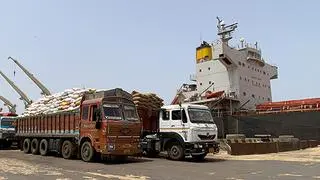James Sangma/Iram Mirza
The alarming IPCC report, declaring code red for humanity, has confirmed the ‘chamber of climate horrors’ playing out for humanity as we surpass our ecological threshold.
In the first seven months of this year alone, swathes of India have experienced two cyclones, a deadly glacier collapse in the Himalayas, a sweltering heat wave, multiple landslides and killer floods.
According to data by Internal Displacement Monitoring Centre (IDMC), in 2020 in India, 3,856,000 people were displaced by environmental disasters, 989 times more than the 3,900 people displaced by conflicts. Around 9.2 million displacements were recorded in the region.
Cyclone Amphan alone triggered 5 million evacuations across Bangladesh, India, Myanmar and Bhutan in May 2020, making it the largest disaster displacement event of the year globally. In India, it triggered more than 2 million evacuations. A World Bank report estimates that 150 millions lives will be lost with 1.5 degree warming.
There is no doubt that climate change is fast upending the foundations of our economies, livelihoods, food security, health and quality of life. And the recent spate of freak weather events have brought devastation into closer view and clearly established that India is in a uniquely vulnerable position with its twin charter of achieving robust growth in the coming decade and tackling the impending climate change challenge.
With the upcoming COP 26 summit in a few months, the pressure on India is mounting to declare its net zero target. The recent declaration of the Union Environment Minister on India’s stance on the long promised environment reparation ($100 billion) from developed nations for adaptation strategies of emerging economies and more recently, its request for G20 nations to achieve their net zero target by 2030 is well argued.
And India is right to call out the global ‘climate caste system’ and press upon the wealthiest countries to deliver on their climate finance commitment. “India’s climate burden is four times its climate guilt,” says climate journalist David Wallace Wells.
But while the global focus on net zero targets is commendable, our climate and environment discourse remains stuck in the ‘Net Zero’ silo, which is just one step in the entire social, economic and societal overhaul — required to restore the planetary eco systems.
As Wells clarifies, “Global warming is one input in the carrying capacity of the Earth. In fact, it is the low hanging fruit. We should not treat Net Zero (emissions) as a form of ‘cognitive bargain’ to reverse climate change. There is a lengthy road beyond Net Zero to achieve a carbon negative environment and a nature positive society.”
Complex climate calculus
Climate calculus is much complex and requires not just a decarbonised economy (based on emissions alone) but recast of agriculture with new approaches to forestry and retirement of dirty supply chains and labour infrastructure. Not just our energy systems but our transportation, industry, agriculture and infrastructure coupled with our diets (meats, dairies) and consumption habits — and addictions to modern day gift horses like internet and cooling — need to be dramatically altered.
Apart from making a compelling case for ‘environment justice’, we also need to be channelling our energy in figuring out a blueprint for obtaining zero emissions from agriculture, deforestation, livestocks and landfills and outlining a national and state strategy for tackling extreme weather.
Deforestation adds 12 per cent of carbon emission while a forest fire contributes to about 25 per cent.
Climate change is not just a region specific issue. Pandemics, crop failures, migration patterns and civil unrest, cyclones, rain and heat events, super drought, and our consumption spiral— all of this is closely interlinked with climate.
According to a recent report, climate shocks are going to make 600 million under-nourished and 100 million chronically hungry in the coming years. We are in a state of climate emergency and we need a set of enhanced domestic climate targets and translate them from the national to State level with a ‘climate informed’ policy overhaul in all major sectors
From regenerative agriculture modelling to prevent soil erosion, and food sovereignty to a critical water strategy/target — 21 Indian cities are bound to lose water supply in the next five years, according to a World Bank report — along with biodiversity conservation, zero waste management models, we have the toolkits available.
We need rapid prototyping of nature based solutions and creation of climate action zones and livelihoods to attract green finance, scientifically created carbon sinks, grants and SDG linked finance solutions to raise capital for funding our survival strategy.
It is true that all of this requires a new economic and social imagination. Governments need to get on war footing to re-cast their policies and models. And that can happen if we are able to galvanise the political will, engineer cultural flexibility and co-ordinate collective action to declare and treat climate change as an urgent political issue and a pressing national security and civilisational threat.
( James Sangma is Minister for Forest and Environment and Power, Meghalaya and Iram Mirza, Advisor to Governments on Impact Programming.)








Comments
Comments have to be in English, and in full sentences. They cannot be abusive or personal. Please abide by our community guidelines for posting your comments.
We have migrated to a new commenting platform. If you are already a registered user of TheHindu Businessline and logged in, you may continue to engage with our articles. If you do not have an account please register and login to post comments. Users can access their older comments by logging into their accounts on Vuukle.